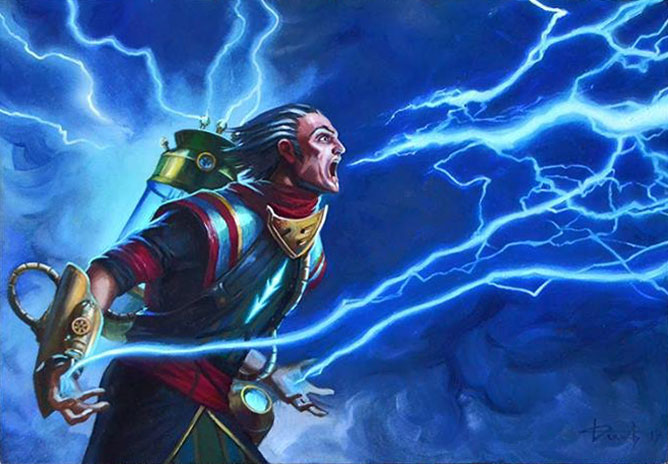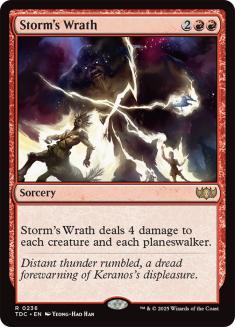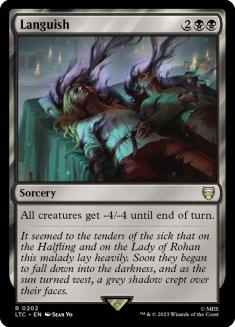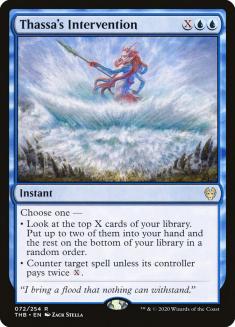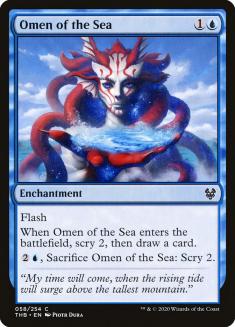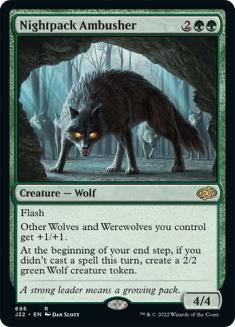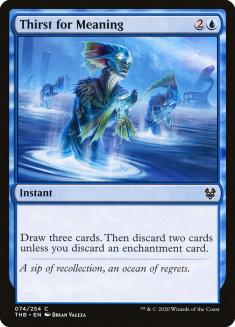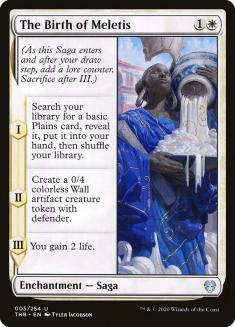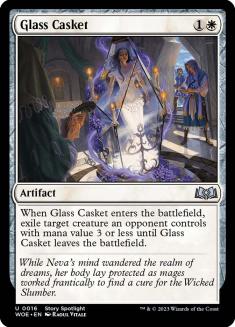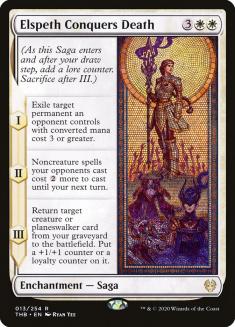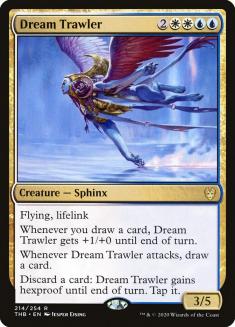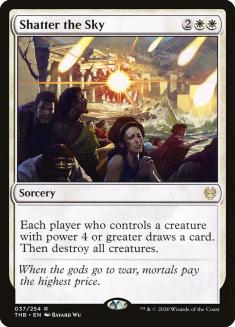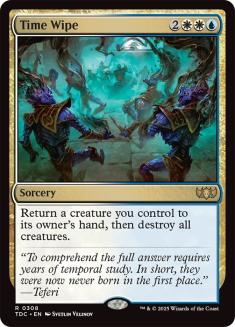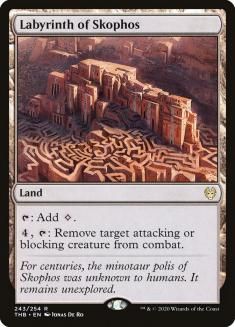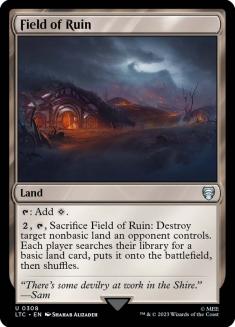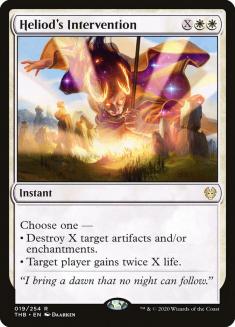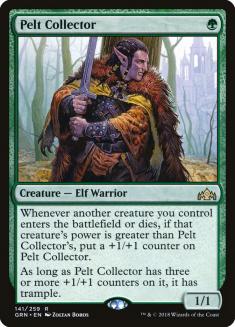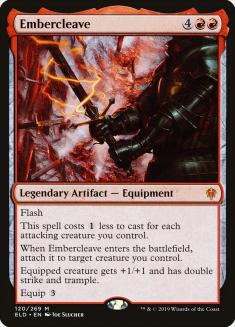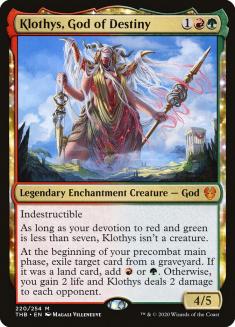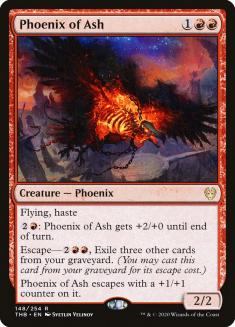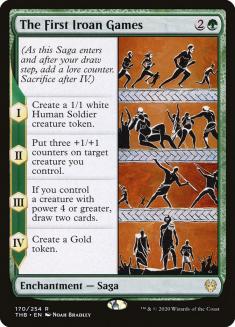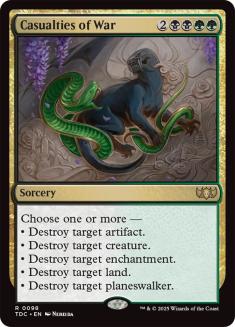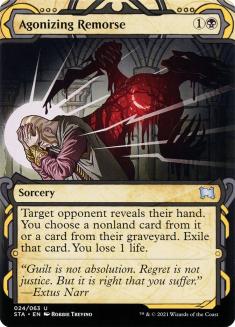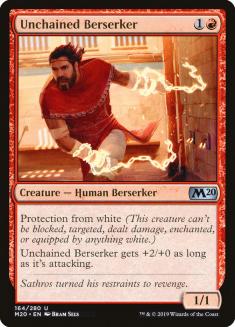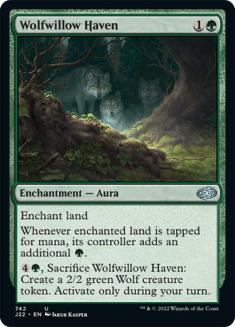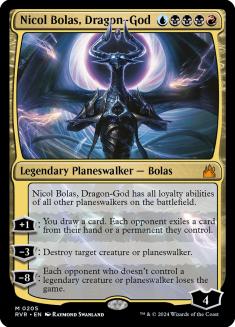Theros Beyond Death has finally come to the paper Magic scene, ushering in a new era of Standard with some serious shake-ups.
Uro, Titan of Nature’s Wrath has proven every bit as powerful as some bold predictions suggested. Ramping, adding card advantage, gaining life, and being an inevitable threat, Uro offers advantages on many axes while also bringing a huge amount of raw power to the table. While it was initially primarily a vehicle for Simic Ramp and Sultai decks, a new style of Uro deck has ascended to the top of the format.
Now that Temur Reclamation decks have figured out how to take advantage of Uro and several other incredible new cards, the archetype skyrocketed to the top of the first major Standard tournament of the new format in paper, the Standard portion of the SCG Open in Richmond.
Here’s a look at the Day 2 metagame, along with a weighted Top 32 metagame, based on how well those strategies fared on Day 2:
| Archetype | Day 2 Metagame | Top 32 Metagame |
| Mono-Red Aggro | 27.0% | 19.0% |
| Azorius Control | 16.2% | 22.2% |
| Temur Reclamation | 16.2% | 30.2% |
| Simic Ramp | 13.5% | 3.2% |
| Jund Sacrifice* | 13.5% | 11.1% |
| Gruul Aggro | 8.1% | 9.5% |
| Rakdos Aggro | 2.7% | 1.6% |
| Mono-White Devotion | 2.7% | 1.6% |
* Jund Sacrifice includes also includes a Mardu Sacrifice and a Rakdos Sacrifice deck.
Mono-Red Aggro being the most popular archetype out of the gate isn’t much of a surprise, as it’s so frequently strong on Day 1 and commonly selected by players unsure of how best to build new strategies with the new set. Interestingly, this time it underperformed, as did most strategies. The only overperforming archetypes were Temur Reclamation, Azorius Control, and to a lesser degree Gruul Aggro.
For starters, let’s take a look at Will Pulliam build of the most successful archetype of the tournament, Temur Reclamation:
Creatures (9)
Lands (27)
Spells (24)
- 4 Expansion
- 4 Growth Spiral
- 4 Wilderness Reclamation
- 4 Omen of the Sea
- 4 Storm's Wrath
- 4 Thassa's Intervention
Sideboard

While Uro is fantastic here, it’s not like we’re actually doing anything particularly interesting to synergize with it. It’s just does a lot of really good stuff at a low cost. More interestingly, Theros Beyond Death really changes the rules of engagement for Temur decks, thanks to Storm’s Wrath.
Storm’s Wrath is the red Languish, but with the incredible added upside of hitting planeswalkers. To say this card is a game-changer is no exaggeration.
Four-toughness creatures have gone from powerful against red to inherently inefficient overnight. Planeswalkers have suddenly become much riskier to play too many of, and being able to hit them with Storm’s Wrath makes it much safer to play a lot of copies maindeck than the various two-damage options of previous builds.
One of the bottlenecks of Wilderness Reclamation decks has been finding powerful ways to convert huge amounts of mana into advantage at instant speed without ending up with a deck that can’t function without a Reclamation on the battlefield.
Thassa’s Intervention is an elegant solution to this problem, serving as reasonable interaction early on, a virtual Dig Through Time when you have Wilderness Reclamation, and a passable draw-two when we don’t.
Likewise, Omen of the Sea is fairly cheap and efficient library manipulation that can be cast as instant speed, whether being flashed down or sacrificed with the mana we get from untapping. Like Thassa’s Intervention, Omen of the Sea is a quality card on its own that happens to function particularly well in this strategy.
Temur Reclamation put an impressive four copies into the Top 8, and while Alex Rubin’s list was quite similar, Harlan Firer and Daniel Goetschel each had some interesting new tech.
Creatures (7)
Lands (27)
Spells (26)
- 1 Negate
- 3 Expansion
- 4 Growth Spiral
- 4 Wilderness Reclamation
- 2 Scorching Dragonfire
- 4 Omen of the Sea
- 4 Storm's Wrath
- 4 Thassa's Intervention
Sideboard

Instead of maindeck Gadwick, the Wizened, Harlan has a couple of extra Scorching Dragonfires for extra early defense. Then, to make up for the missing victory conditions, he’s packing a sweet transformational sideboard plan that curves perfectly with Wilderness Reclamation.
I love this plan, as it’s super-synergistic with everything we’re doing and can completely take over a game on its own, especially if we catch an opponent without enough of the right kind of removal after sideboarding.
Creatures (8)
Lands (27)
Spells (25)
- 3 Expansion
- 4 Growth Spiral
- 4 Wilderness Reclamation
- 1 Scorching Dragonfire
- 4 Omen of the Sea
- 2 Thirst for Meaning
- 3 Storm's Wrath
- 4 Thassa's Intervention
Sideboard

Daniel Goetschel also had some of the Nightpack Ambusher plan in the sideboard, but still found room for a Gadwick in the main. What’s more, he had a little extra card draw in the form of Thirst for Meaning.
We’ve been seeing Thirst for Meaning out of Azorius Control decks, but with both Omen of the Sea and Wilderness Reclamation, it could be fine here. I don’t think I’m into it, however, as I just don’t want to discard Wilderness Reclamations, and that’s to say nothing of how loath I am to shave any Storm’s Wrath.
Besides, if even the Azorius Control decks are cutting Thirst for Meaning, I’m not sure I want to add it here…
Creatures (4)
Planeswalkers (8)
Lands (25)
Spells (23)

While Temur Reclamation had the best numbers overall, Corey Baumeister and his update to Azorius Control took home the trophy. While Corey has cut Thirst for Meaning, he’s still running both Omen of the Sea and The Birth of Meletis.
Both let him smooth out his draws early, while giving him a few extra options in places. This isn’t to say the enchantment count is still the same, however. In addition to shaving one The Birth of Meletis, this new non-Thirst build eschews Banishing Light entirely, instead running Glass Casket for faster defense.
He does have one other enchantment, of course; but I don’t think he’s trying to discard Elspeth Conquers Death. Anyone playing three copies maindeck clearly means it!
The white The Eldest Reborn has surged in popularity, and Control Superstar Shaheen Soorani even goes so far as to play a fourth copy in his sideboard!
Creatures (7)
Planeswalkers (8)
Lands (25)
Spells (20)

Rather than just playing a different card draw spell, Corey and Shaheen are playing an above-average number of tap-out threats with extra copies of the white The Eldest Reborn, a playset of Narsets, and a full playset of Dream Trawlers.
Enough has been said on Dream Trawler, so suffice it to say, it’s the real deal and a staple in Pioneer, let alone Standard.
Shatter the Sky appearing in big numbers is no surprise, but I like the use of Time Wipe here as a fifth sweeper. With so few counterspells and so little spot removal, the extra sweeper is great, even if we don’t get as much advantage as some from the ability to bounce a creature.
Both of the above manabases are most interesting for what’s missing, which is colorless lands of any variety. They’ve already got so many more late-game advantages from the quantity of powerful tap-out threats, so I could see it making sense to just want your early-game mana to be as consistent as possible.
Great card, both against red aggro and against anyone overly reliant on enchantments. I don’t think it’d be crazy to play a third copy in some metagames.
As mentioned above, this tournament really belonged to Temur and Azorius; however, Dylan Gellis’s finish with Gruul Aggro suggests the archetype might warrant a closer look.
Creatures (29)
- 4 Pelt Collector
- 4 Gruul Spellbreaker
- 2 Skarrgan Hellkite
- 4 Zhur-Taa Goblin
- 3 Paradise Druid
- 4 Lovestruck Beast
- 4 Questing Beast
- 4 Bonecrusher Giant
Planeswalkers (2)
Lands (24)
Spells (5)

These decks are so overcrowded at the three-spot, something has to give. In order to better capitalize on the Pelt Collector / Embercleave package, Dylan has cut Klothys, God of Destiny completely from his 75.
This is not to say he’s got nothing new, however. I’m definitely into Phoenix of Ash, a nice threat for fighting through removal and pressuring planeswalkers.
Additionally, we see one copy of The Akroan War for randomly beating up on opposing green creatures. Uro isn’t the worst creature to steal for a turn, you know…
Creatures (25)
- 3 Paradise Druid
- 4 Lovestruck Beast
- 4 Questing Beast
- 4 Edgewall Innkeeper
- 4 Bonecrusher Giant
- 4 Rimrock Knight
- 2 Klothys, God of Destiny
Lands (24)
Spells (11)

Erik Jones’s list has the same core and a lot of the same cards, but ends with the Edgewall Innkeeper package and a couple of copies of Klothys. He’s also got three The First Iroan Games, which is absolutely fantastic when you’re not trying to support Pelt Collector.
With so many decks in the metagame revolving around Embercleave or blue card draw, it’s not surprising to see such a major decline of Casualties of War.
The highest-finishing “Casualties of War deck” belongs to Dylan Hand. Here’s his update to the returning strategy:
Creatures (23)
- 3 Thrashing Brontodon
- 4 Mayhem Devil
- 1 Massacre Girl
- 1 God-Eternal Bontu
- 4 Gilded Goose
- 3 Korvold, Fae-Cursed King
- 3 Murderous Rider
- 4 Cauldron Familiar
Planeswalkers (1)
Lands (25)
Spells (11)

Instead of any Casualties of War or temporary stealing effects, he’s maindecking Agonizing Remorse for hand disruption to help exploit the relative lack of permission in Azorius and Temur.
While this seems like a good version of this archetype, I think it also reveals why this might not be the best time for Cauldron Familiar decks. Once you’re playing zero Casualties of War in the maindeck, how sure can you be that you should even be going down this path?
It does make sense, though, as Casualties of War isn’t necessarily at its best against decks that keep all their action in their hand, nor against fast aggro decks, such as Jake Mondello’s Mono-Red Aggro.
Creatures (29)
- 4 Runaway Steam-Kin
- 4 Scorch Spitter
- 4 Fervent Champion
- 4 Bonecrusher Giant
- 3 Torbran, Thane of Red Fell
- 4 Rimrock Knight
- 4 Anax, Hardened in the Forge
- 2 Phoenix of Ash
Lands (23)
Spells (8)
- 4 Shock
- 4 Embercleave

In addition to the addition of Phoenix of Ash, Jake has built around Anax, Hardened in the Forge.
In addition to huge damage potential, Anax is a mustkill threat that leaves behind another attacker (and frequently, two). Despite the relative lack of ways to get Anax through, he does make a great fit here. This many permanents ensures your devotion to red will generally be quite high, and the protection against Shatter the Sky and Storm’s Wrath is huge.
All these cheap, aggressive escape threats allow us to semi-transform into a different kind of red deck well-suited to grinding through removal and sweepers. The explosiveness of Embercleave, Anax, and Torbran will generally have people looking for as much fast removal as they can get their hands on. This sets us up to shift our focus to the Phoenix, Berserker, Mobilized District, and Experimental Frenzy.
Rounding out the Day 2 field, we’ve got Simic Ramp, but I think it’s kind of a worse Temur deck. Still, Dan Salvatore’s use of Wolfwillow Haven does spark a little interest.
Wolfwillow Haven is a two-cost accelerator in a world of three-cost options. The late-game option isn’t particularly powerful, but it’s better than nothing. Really though, we’re just playing it for the two-into-four curve.
Creatures (19)
- 4 Hydroid Krasis
- 1 End-Raze Forerunners
- 1 Agent of Treachery
- 4 Cavalier of Thorns
- 4 Gilded Goose
- 2 Wicked Wolf
- 3 Uro, Titan of Nature's Wrath
Planeswalkers (4)
Lands (27)
Spells (10)
Sideboard

Finally, here’s a look at James Hathcock’s stab at Mono-White Devotion, an archetype I think could have potential but isn’t quite done cooking yet.
Creatures (28)
- 4 Ajani's Pridemate
- 4 Healer's Hawk
- 1 Tomik, Distinguished Advokist
- 4 Linden, the Steadfast Queen
- 4 Hushbringer
- 3 Daxos, Blessed by the Sun
- 4 Heliod, Sun-Crowned
- 4 Alseid of Life's Bounty
Planeswalkers (4)
Lands (24)
Spells (4)

There’s a lot to like here, but sadly, I think this just isn’t the metagame for this style of deck. Shatter the Sky and Storm’s Wrath are both brutal, and while we’re quite favored against red aggro, that archetype is likely to be on the decline after this weekend.
Moving forward, I expect Temur Reclamation and Azorius Control to gain popularity and continue to succeed, but I think we’re likely to see some adjustments made to other strategies, given the decline of aggro and rise of blue decks with lots of card draw and not a lot of permission. Various flash decks, black devotion, and Esper Hero all look interesting, and red aggro will return, likely a little smaller and faster than before.
Me? I’ve got my eye on somebody else…

